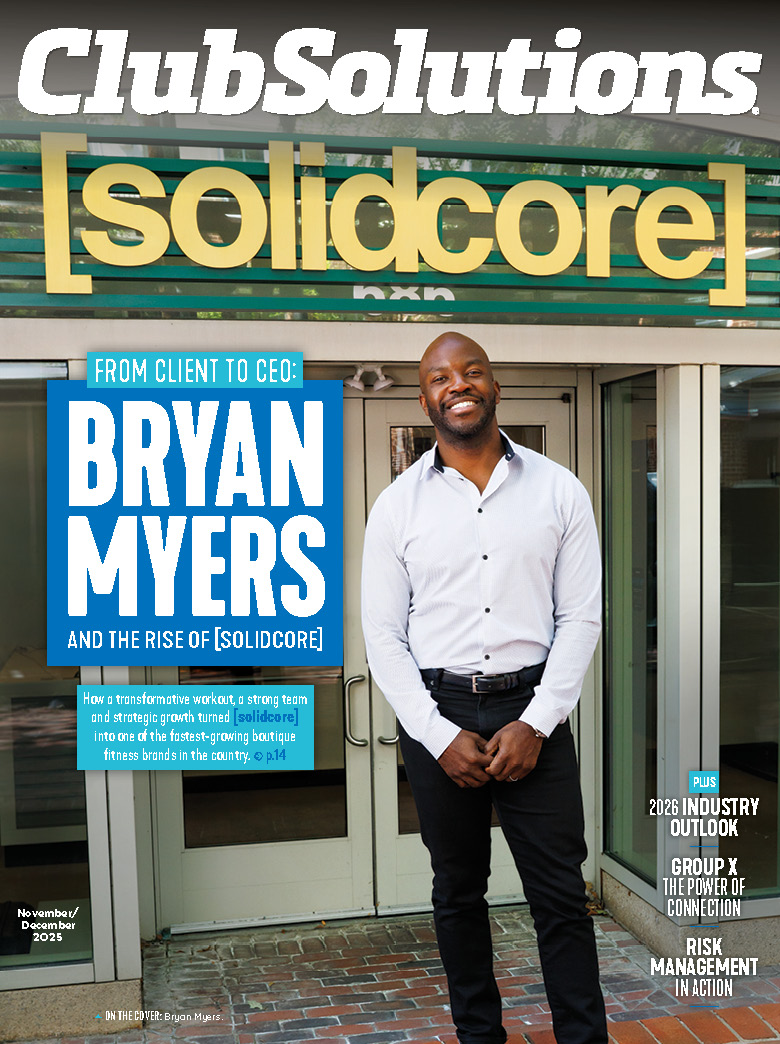Raphael Konforti, the senior director of fitness at YouFit, shares eight ways to lead personal training at your health club as a general manager.
Throughout COVID-19, many organizations have endured restructures and redefined roles. Many operations, fitness and membership specialists now need to flex to all areas of the business while maintaining strong sales and revenue growth to rebound from 2020.
Personal training offers a huge opportunity to drive additional revenue per member and bottom line earnings before interest, taxes, depreciation and amortization. Even one dollar more per member drastically impacts the bottom line at scale.
This has left many club managers and even executives in a position where they need to manage and grow personal training themselves. Even if that’s not the case, if you want to truly grow in the fitness industry and rise up the ranks, you have to be versed in all facets of the business from fitness, to membership, to operations to retail.
The biggest challenge with this change is personal training can be intimidating to lead without having done those roles yourself. You know prospects feel anxious walking through your doors. Employees also feel that same anxiety when managing fitness employees for many of the same reasons. They don’t want to look like they don’t know what they’re doing. They’re intimidated to manage someone who knows more than them. On top of that, personal trainers operate on different schedules. If you can relate, that’s actually a good thing, it means you respect the fitness team and want to do a good job. I’ll ask you to consider this:
The people who run hospitals are not always doctors. In fact, a friend of mine is a COO for a large hospital and he has no medical degrees. Clearly you can manage and lead specialists without having done the role. It requires a different management approach, empathy and a lot of listening, but it can be done.
Another example is air traffic control staff. Are they pilots? Almost never. Can they still provide value and guide the pilots to do their job effectively? Of course.
The bottom line is you can still help your trainers grow without being a certified personal trainer (CPT).
Here are eight ways you can grow your personal training team:
Get to Know the Team and Their Goals
It always starts here. No team will work hard for you and respect you if you haven’t taken the time to get to know them as a person. Trainers in particular want to be respected for the time they’ve spent getting certifications and respected for knowing what they’re doing.
Show them you care about them and their success. Show them you are here to help them reach their goals at your gym and beyond. This takes you from the manager who tells people what to do all the time to the mentor people seek feedback from.
My favorite place to start is asking how they got into working out, what inspired them to become a trainer and what they want to accomplish as a trainer.
From there you always need to establish a goal. The simplest goal is how much money they need and want to make. Figure out how many sessions and sales that works out to be and show them you are there to help them reach that goal as fast as possible.
Know and Set Expectations
Make sure your team knows what success looks like and they can see their progress toward it. How much money do they want to make and how much are they currently making? What’s your company’s expectation for sales and sessions? Can they easily see their stats on a whiteboard or a report? On a daily, weekly and monthly basis, do they know if they are winning or losing?
A simple breakdown of winning versus losing is evaluating their sessions serviced, sales and client retention or cancellations. Is their book growing, stagnant or dwindling? Then are those up to company standards? Is it in-line with their goals for income and impact? How often will you meet to review this and other expectations?
Constantly keep these goals and standards front of mind for them. Each day, ask them how many sessions and sales they have for the day and month to date. Don’t wait until payday to talk about how much money they made and a game plan to hit their goals.
Lean into Sales and Roleplaying
To reach those expectations and service more sessions you need to sell. Selling personal training is put up a pedestal far too often. It’s more expensive than a membership, but it’s also vastly more effective for reaching goals than walking around the gym copying exercises other members are doing.
If you know how to work with your front desk on prospecting phone calls and membership sales, you can easily translate that skill set over to training. The concept is the same. The member has a problem and you have the solution. The same open-ended questions, reflective listening, affirmations, paraphrasing and membership prescription are the ones used in selling personal training.
Personal training is an emotional purchase not a technical purchase. Science helps sell, however the best personal training sales people are good at uncovering hot buttons, asking follow-up questions and prescribing the solution with confidence. Some of the best personal training salespeople were never certified and never worked as trainers. Just imagine how effective you can make your trainers at selling when you combine your membership sales skills with their fitness knowledge.
Additionally, most clients don’t care about science; they want to know working with a personal trainer will work and it’s not a waste of time and money. If results were 100% guaranteed, how could you not hire a trainer?
Coach The Basics
There are many non-negotiables for any position in the gym. You need to be on time, in uniform, friendly, engaged and coachable. Remember to set and follow up with these basic expectations. Everyone in your gym needs to be held to the same standard. Members are always watching your trainers, they won’t want to work with the trainer that looks sloppy, never smiles, leans on machines and scrambles to sessions. Any manager can and needs to coach trainers on these basics.
This standard sets the precedent for the other expectations we’ll cover further down and keeps the trainers part of the team versus developing an independent contractor mentality.
At the end of the day, how you do anything is how you do everything.
Review Programming
You need to check in with trainers to ensure workouts are programmed ahead of time and intentional. There is no world where it’s OK for a trainer to record a workout during a session or to make it up on the fly.
You may not know whether a program’s rest periods match the rep scheme in a workout but you do know if the workout was planned and prepared ahead of time. You may not know if the low bar versus high bar squat was appropriate for that client based on their movement assessment. But, you can tell if the trainer had a purpose for choosing that exercise or if it was a roll of the dice. Ask the trainer why they chose that exercise, if they’re quick to provide a why or stumble through an answer, that shows they rolled the dice on choosing an exercise.
If they can’t articulate why they chose an exercise to you then they’re not building value during sessions. Trainers always need to explain to clients why exercises and programs are right for them.
Tell Me Why
Asking why they chose an exercise ties into the next question: How well do they know their clients?
Personal training comes down to relationships and results. If a client loses 20 pounds that’s great. If they don’t have a connection with their trainer they may still be unhappy with those results and they won’t stick around to keep that 20 pounds off.
I like to play a game with the trainers where I pick a random client and I start asking them questions. This tells me how much of a relationship is built, along with identifying results.
- Tell me a little bit about this client?
- How long have you worked together?
- How often do you train together? What days and times? When is your next session?
- Are they using up their sessions at that pace or are they building up sessions?
- What were their goals when they started working with you? From 1-10 how happy are they with their results so far? Now that you’ve been working together for X time, how have their goals changed? (Your gym should have tools trainers follow to track results and satisfaction with their trainer, check on this regularly).
- What type of workouts and equipment do they like? What do they hate? How have you programmed for them based on this?
- What do they like to do outside of the gym?
- What do they do for work?
- Are they in a relationship? Do they have kids or pets?
One of the biggest missteps I see with trainers is they think they are there to put people through a workout and nothing more. Even if you hire outgoing trainers you need to watch for this. They may be good at getting clients off the floor however outgoing people are better at talking than listening.
Again, you may not know whether the answers are scientifically correct. That’s OK, you don’t need a CPT to ask these questions. The point is to evaluate how well they know the client and if they’re using that information to build a better program and relationship.
Go through this with every single client and prospect on a monthly basis with each trainer.
Keep a Consistent Calendar
Does their calendar magically populate as the days go on or can you scroll through weeks and see consistency with sessions in the past and future?
Trainers cancelling and rescheduling appointments lead to very short client lifespans. Anyone can look at a calendar to know if the trainer is organized and reliable. Trainers must maintain an up-to-date calendar at least two weeks out, and if it changes it’s because the client needed to reschedule, not the trainer. As soon as a trainer starts moving sessions around the client has the greenlight to do the same and the downward spiral commences. Even if it’s a cold rainy day and six clients have cancelled, you never cancel client No. 7.
Make sure you set the standard for managing their calendar and when they will be working. Trust but inspect regularly.
Show Vulnerability
Your trainers know you’re not certified and don’t have 2,000 hours of sessions under your belt. Acting like you do guarantees your next trainer one-on-one will be full of eye rolls and smirks. The trainer is there because they are great at training people, however you can provide wisdom of the overall gym business and people skills. Remember many trainers joining the industry are young with limited career experience. Lean on your experience of life and working to provide value to your team.
Encourage your trainers to be vulnerable as well. It’s impossible to know everything about fitness, especially since research constantly evolves. It’s OK to tell a client you want to do more research or consult with another trainer before answering a question. Doesn’t your doctor consult another doctor when they’re not sure?
When your trainer needs help with a fitness question, use your connections to point them toward a knowledgeable trainer or help them look for reputable resources on the topic. Encourage them to reach out to their certification or reputable blogs to find answers. Teach them how to fish.
Conclusion
As a young trainer I was intimidated to train doctors, lawyers and retired executives. They knew more about finances, sales, relationships, contract negotiations, real estate and frankly everything except fitness. They didn’t look down on me for that, they loved teaching me. You’re in the same position as those clients were. Even if you’re not a fitness expert you have plenty of value to add.
As someone with a master’s in exercise science and countless certifications, I can tell you I very rarely use that depth of knowledge when working with trainers. Most clients don’t care about the detailed science – they just want someone to help them. Trainers are the same, they just want someone to believe in them and help them grow.










